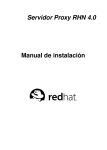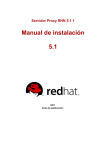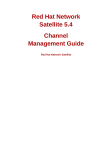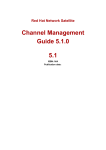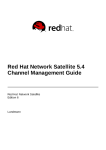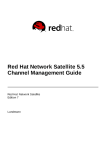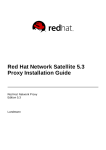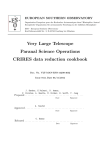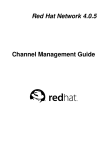Download Red Hat NETWORK PROXY SERVER 3.6 - Installation guide
Transcript
RHN Proxy Server 4.0 Installation Guide RHN Proxy Server 4.0: Installation Guide Copyright © 2001 - 2005 by Red Hat, Inc. Red Hat, Inc. 1801 Varsity Drive Raleigh NC 27606-2072 USA Phone: +1 919 754 3700 Phone: 888 733 4281 Fax: +1 919 754 3701 PO Box 13588 Research Triangle Park NC 27709 USA RHNproxy(EN)-4.0-RHI (2005-04-20T13:40) Copyright © 2005 by Red Hat, Inc. This material may be distributed only subject to the terms and conditions set forth in the Open Publication License, V1.0 or later (the latest version is presently available at http://www.opencontent.org/openpub/). Distribution of substantively modified versions of this document is prohibited without the explicit permission of the copyright holder. Distribution of the work or derivative of the work in any standard (paper) book form for commercial purposes is prohibited unless prior permission is obtained from the copyright holder. Red Hat and the Red Hat "Shadow Man" logo are registered trademarks of Red Hat, Inc. in the United States and other countries. All other trademarks referenced herein are the property of their respective owners. The GPG fingerprint of the [email protected] key is: CA 20 86 86 2B D6 9D FC 65 F6 EC C4 21 91 80 CD DB 42 A6 0E Table of Contents 1. Introduction..................................................................................................................................... 1 1.1. Red Hat Network ............................................................................................................... 1 1.2. RHN Proxy Server ............................................................................................................. 1 1.3. Terms to Understand .......................................................................................................... 2 1.4. How it Works ..................................................................................................................... 3 2. Requirements................................................................................................................................... 5 2.1. Software Requirements...................................................................................................... 5 2.2. Hardware Requirements..................................................................................................... 6 2.3. Disk Space Requirements .................................................................................................. 6 2.4. Additional Requirements ................................................................................................... 6 3. Example Topologies ........................................................................................................................ 9 3.1. Single Proxy Topology ...................................................................................................... 9 3.2. Multiple Proxy Horizontally Tiered Topology .................................................................. 9 3.3. Multiple Proxy Vertically Tiered Topology ..................................................................... 10 3.4. Proxies with RHN Satellite Server .................................................................................. 11 4. Installation ..................................................................................................................................... 13 4.1. Base Install....................................................................................................................... 13 4.2. RHN Proxy Server Installation Process ........................................................................... 13 5. RHN Package Manager................................................................................................................ 21 5.1. Creating a Private Channel .............................................................................................. 21 5.2. Uploading Packages......................................................................................................... 21 5.3. Command Line Options................................................................................................... 22 6. Troubleshooting............................................................................................................................. 25 6.1. Managing the Proxy Service............................................................................................ 25 6.2. Log Files .......................................................................................................................... 25 6.3. Questions and Answers.................................................................................................... 25 6.4. General Problems............................................................................................................. 26 6.5. Host Not Found/Could Not Determine FQDN ................................................................ 26 6.6. Connection Errors ............................................................................................................ 27 6.7. Caching Issues ................................................................................................................. 27 6.8. Proxy Debugging by Red Hat .......................................................................................... 28 A. Sample RHN Proxy Server Configuration File ......................................................................... 31 Index................................................................................................................................................... 33 Chapter 1. Introduction 1.1. Red Hat Network Red Hat Network (RHN) is the environment for system-level support and management of Red Hat systems and networks of systems. Red Hat Network brings together the tools, services, and information repositories needed to maximize the reliability, security, and performance of their systems. To use RHN, system administrators register the software and hardware profiles, known as System Profiles, of their client systems with Red Hat Network. When a client system requests package updates, only the applicable packages for the client are returned (based upon the software profile stored on the RHN Servers). Advantages of using Red Hat Network include: • Scalability — with Red Hat Network, a single system administrator can set up and maintain hundreds or thousands of Red Hat systems more easily, accurately, and quickly than they could maintain a single system without Red Hat Network. • Standard Protocols — standard protocols are used to maintain security and increase capability. For example, XML-RPC gives Red Hat Network the ability to do much more than merely download files. • Security — all communication between registered systems and Red Hat Network takes place over secure Internet connections. • View Errata Alerts — easily view Errata Alerts for all your client systems through one website. • Scheduled Actions — use the website to schedule actions, including Errata Updates, package installs, and software profile updates. • Simplification — maintaining Red Hat systems becomes a simple, automated process. 1.2. RHN Proxy Server An RHN Proxy Server is a service deployed within a corporate network with advanced Red Hat Network functionality, such as a package-caching mechanism for reduced bandwidth usage and customizable channels enabling custom package deployment. This service allows a business or corporation to cache RPM Updates on an internal, centrally located RHN Proxy Server and have the client systems download the updates from that server instead of from one of the RHN Servers 1 over the Internet. The clients’ System Profiles and user information are stored on the secure, central RHN Servers, which also serve the RHN website (rhn.redhat.com). The Proxy acts as a go-between for client systems and Red Hat Network (or an RHN Satellite Server). Only the package files are stored on the RHN Proxy Server. Every transaction is authenticated, and the Red Hat Update Agent checks the GPG signature of each package retrieved from the local RHN Proxy Server. In addition to storing official Red Hat packages, the RHN Proxy Server can be configured to deliver an organization’s own custom packages from private RHN channels, using the RHN Package Manager. 1. Throughout this document, replace RHN Server with RHN Satellite Server if the RHN Proxy Server connects to a RHN Satellite Server instead. 2 Chapter 1. Introduction For instance, an organization could develop its own software, package it in an RPM, sign it with its own GPG signature, and have the local RHN Proxy Server update all the individual systems in the network with the latest versions of the custom software. Advantages of using RHN Proxy Server include: • Scalability — there can be multiple local RHN Proxy Servers within one organization. • Security — an end-to-end secure connection is maintained: from the client systems, to the local RHN Proxy Server, to the Red Hat Network servers. • Saves time — packages are delivered significantly faster over a local area network than the Internet. • Saves bandwidth — packages are downloaded from the RHN File servers only once (per local Proxy Server’s caching mechanism) instead of downloading each package to each client system. • Saves disk space on individual systems — one large disk array is required instead of extra disk space on all the client systems. • Customized updates — create a truly automated package delivery system for custom software packages, as well as official Red Hat packages required for the client systems. Custom private RHN channels allow an organization to automate delivery of in-house packages. • Customized configuration — restrict or grant updates to specific architectures and OS versions. • Only one Internet connection required — the client systems connect only through the HTTPenabled Proxy Server and therefore do not need a connection to the external network (Internet), but only require access to the Local Area Network to which the RHN Proxy Server is connected. Only the RHN Proxy Server needs an Internet connection to contact the RHN Servers, unless the RHN Proxy Server is using a RHN Satellite Server, in which case only the RHN Satellite Server requires an Internet connection. 1.3. Terms to Understand Before understanding RHN Proxy Server, it is important to become familiar with the following Red Hat Network terms: • Channel — A channel is a list of software packages. There are two types of channels: base channels and child channels. A base channel consists of a list of packages based on a specific architecture and Red Hat release. A child channel is a channel associated with a base channel but contains extra packages. • Organization Administrator — Organization Administrator is a user role with the highest level of control over an organization’s Red Hat Network account. Members with this role can add other users, other systems, and system groups to the organization, as well as remove them. A Red Hat Network organization must have at least one Organization Administrator. • Channel Administrator — A Channel Administrator is a user role with full access to channel management capabilities. Users with this role are capable of creating channels and assigning packages to channels. This role can be assigned by an Organization Administrator through the Users tab of the RHN website. • Chapter 1. Introduction 3 Red Hat Update Agent — The Red Hat Update Agent is the Red Hat Network client application (up2date) that allows users to retrieve and install new or updated packages for the client system on which the application is run. • Traceback — A traceback is a detailed description of "what went wrong" that is useful for troubleshooting the RHN Proxy Server. Tracebacks are automatically generated when a critical error occurs and are mailed to the individual(s) designated in the RHN Proxy Server’s configuration file. For more detailed explanations of these terms and others, refer to the Red Hat Network Reference Guide available at http://www.redhat.com/docs/. 1.4. How it Works The Red Hat Update Agent on the client systems does not directly contact a Red Hat Network Server. Instead, the client (or clients) connects to an RHN Proxy Server that connects to the Red Hat Network Servers or to a RHN Satellite Server. Thus, the client systems do not need direct access to the Internet. They need access only to the RHN Proxy Server. Important Red Hat strongly recommends that clients connected to RHN Proxy Server be running the latest update of Red Hat Enterprise Linux to ensure proper connectivity. By default, a client is authenticated directly by Red Hat Network Servers. Using an RHN Proxy Server, authentication works similarly except that the RHN Proxy Server provides route information as well. After a successful authentication, the Red Hat Network Server informs the RHN Proxy Server that it is permitted to execute a specific action for the client. The RHN Proxy Server downloads all of the updated packages (if they are not already present in its cache) and delivers them to the client system. Requests from the Red Hat Update Agent on the client systems are still authenticated on the server side, but package delivery is significantly faster since the packages are cached in the HTTP Proxy Caching Server or the RHN Proxy Server (for local packages); the RHN Proxy Server and client system are connected via the LAN and are limited only by the speed of the local network. Authentication is done in the following order: 1. The client performs a login action at the beginning of a client session. This login is passed through one or more RHN Proxy Servers until it reaches a Red Hat Network Server. 2. The Red Hat Network Server attempts to authenticate the client. If authentication is successful, the server then passes back a session token via the chain of RHN Proxy Servers. This token, which has a signature and expiration, contains user information, including subscribe-to channels, username, etc. 3. Each RHN Proxy Server caches this token on its local file system in /var/cache/rhn/. Caching reduces some of the overhead of authenticating with Red Hat Network Servers and greatly improves the performance of Red Hat Network. 4. This session token is passed back to the client machine and is used in subsequent actions on Red Hat Network. From the client’s point of view, there is no difference between an RHN Proxy Server and a Red Hat Network Server. From the Red Hat Network Server’s point of view, an RHN Proxy Server is a special type of RHN client. Clients are thus not affected by the route a request takes to reach a Red 4 Chapter 1. Introduction Hat Network Server. All the logic is implemented in the RHN Proxy Servers and Red Hat Network Servers. Optionally the RHN Package Manager can be installed and configured to serve custom packages written specifically for the organization. These are not official Red Hat packages. After creating a private RHN channel, the custom RPM packages are associated with the private channel by uploading the package headers to the RHN Servers. Only the headers are uploaded, not the actual package files. The headers are required because they contain crucial RPM information, such as software dependencies, that allows RHN to automate package installation. The actual custom RPM packages are stored on the RHN Proxy Server and sent to the client systems from inside the organization’s local area network. Configuring a computer network to use RHN Proxy Servers is straightforward. The Red Hat Network applications on the client systems must be configured to connect to the RHN Proxy Server instead of the Red Hat Network Servers. Refer to the RHN Client Configuration Guide for details. On the proxy side, one has to specify the next proxy in the chain (which will eventually end with a Red Hat Network Server). If the RHN Package Manager is used, the client systems must be subscribed to the private RHN channel. Chapter 2. Requirements These requirements must be met before installation. To install RHN Proxy Server version 3.6 or later from RHN Satellite Server, the Satellite itself must be version 3.6 or later. 2.1. Software Requirements To perform an installation, the following software-related components must be available: • Base operating system — RHN Proxy Server is supported with Red Hat Enterprise Linux AS 3 Update 5 or later, or Red Hat Enterprise Linux AS 4 only. The operating system can be installed from disc, local ISO image, kickstart, or any of the methods supported by Red Hat. Important If you plan to obtain Monitoring-level service, you must install your RHN Proxy Server on Red Hat Enterprise Linux AS 3 Update 5 or Red Hat Enterprise Linux AS 4. These are the only supported base operating systems for Proxies serving Monitoring-entitled systems. Each version of Red Hat Enterprise Linux AS requires a certain package set to support RHN Proxy Server. Anything more can cause errors during installation. Therefore, Red Hat recommends obtaining the desired package set in the following ways: Note For kickstarting either Red Hat Enterprise Linux AS 4 or Red Hat Enterprise Linux AS 3 Update 5, specify the following package group: @ Base For installing Red Hat Enterprise Linux AS 4 or Red Hat Enterprise Linux AS 3 Update 5 via CD or ISO image, select the following package group: Minimal Warning Security-enhanced Linux (SELinux) must be disabled in Red Hat Enterprise Linux AS 4 prior to installation of RHN Proxy Server. To do this during CD or ISO image installation, select Disabled when presented with options for SELinux support. To do this for kickstart installation, include the command selinux --disabled or wait for the install to complete, edit the /etc/selinux/config file to read SELINUX=disabled and reboot the system. • An available RHN Proxy Server entitlement within your Red Hat Network account. • An available Provisioning entitlement within your Red Hat Network account (which should come packaged with your RHN Proxy Server entitlement). • Access to the Red Hat Network Tools channel for the installed version of Red Hat Enterprise Linux AS. • All rhncfg* packages installed on the Proxy (from the RHN Tools channel). • Either the rhns-certs-tools package installed on the Proxy (from the RHN Tools channel) or the secure sockets layer (SSL) CA certificate password used to generate the parent server certificate (such as on an RHN Satellite Server). 6 Chapter 2. Requirements • Configuration of the system to accept remote commands and configuration management through Red Hat Network. Refer to Section 4.2 RHN Proxy Server Installation Process for instructions. 2.2. Hardware Requirements The following hardware configuration is required for the RHN Proxy Server: • Pentium III processor, 1.26GHz, 512K cache or equivalent • 512 MB of memory • 3 GB storage for base install of Red Hat Enterprise Linux AS • 6 GB storage per distribution/channel The load on the Apache HTTP Server is directly related to the frequency with which client systems connect to the Proxy, so if you reduce the default interval of four hours (or 240 minutes) as set in the /etc/sysconfig/rhn/rhnsd configuration file of the client systems, you will increase the load on this component significantly. 2.3. Disk Space Requirements The caching mechanism used by RHN Proxy Server is the Squid HTTP proxy, which saves significant bandwidth for the clients. It should have a reasonable amount of space available. The cached packages are stored in /var/spool/squid. The required free space allotment is 6 GB storage per distribution/channel. If the RHN Proxy Server is configured to distribute custom, or local packages, make sure that the /var mount point on the system storing local packages has sufficient disk space to hold all of the custom packages, which are stored in /var/spool/rhn-proxy. The required disk space for local packages depends on the number of custom packages served. 2.4. Additional Requirements The following additional requirements must be met before the RHN Proxy Server installation can be considered complete: • Full Access Client systems need full network access to the RHN Proxy Server services and ports. • Firewall Rules The RHN Proxy Server solution can be firewalled from the Internet, but it must be able to issue outbound connections to the Internet on ports 80 and 443. In addition, if the Proxy will be connected to an RHN Satellite Server that will be configured to push actions to client systems and the Proxy, you must allow inbound connections on port 5222. • Synchronized System Times There is great time sensitivity when connecting to a Web server running SSL (Secure Sockets Layer); it is imperative the time settings on the clients and server are reasonably close together so the SSL certificate does not expire before or during use. It is recommended Network Time Protocol (NTP) be used to synchronize the clocks. • Fully Qualified Domain Name (FQDN) The system upon which the RHN Proxy Server will be installed must resolve its own FQDN properly. Chapter 2. Requirements • 7 A Red Hat Network Account Customers who will be connecting to the central Red Hat Network Servers to receive incremental updates will need an account with Red Hat Network. This account should be set up at the time of purchase with the sales representative. • Backups of Login Information It is imperative customers keep track of all primary login information. For RHN Proxy Server, this includes usernames and passwords for the Organization Administrator account and SSL certificate generation. Red Hat strongly recommends this information be copied onto two separate floppy disks, printed out on paper, and stored in a fireproof safe. • Distribution Locations Since the Proxy forwards virtually all local HTTP requests to the central RHN Servers, you must take care to put files destined for distribution (such as in a kickstart installation tree) in the nonforwarding location on the Proxy: /var/www/html/pub/. Files placed in this directory can be downloaded directly from the Proxy. This can be especially useful for distributing GPG keys or establishing installation trees for kickstarts. In addition, Red Hat recommends the system running the code not be publicly available. No users but the system administrators should have shell access to these machines. All unnecessary services should be disabled. You can use ntsysv or chkconfig to disable services. Finally, you should have the following technical documents in hand for use in roughly this order: 1. The RHN Proxy Server Installation Guide — This guide, which you are now reading, provides the essential steps necessary to get an RHN Proxy Server up and running. 2. The RHN Client Configuration Guide — This guide explains how to configure the systems to be served by an RHN Proxy Server or RHN Satellite Server. (This will also likely require referencing The RHN Reference Guide, which contains steps for registering and updating systems.) 3. The RHN Channel Management Guide — This guide identifies in great detail the recommended methods for building custom packages, creating custom channels, and managing private Errata. 4. The RHN Reference Guide — This guide describes how to create RHN accounts, register and update systems, and use the RHN website to its utmost potential. This guide will probably come in handy throughout the installation and configuration process. 8 Chapter 2. Requirements Chapter 3. Example Topologies The RHN Proxy Server can be configured in multiple ways. Select one method depending on the following factors: 1. The total number of client systems to be served by the 2. The maximum number of clients expected to connect concurrently to the RHN Proxy Server. 3. The number of custom packages and channels to be served by the RHN Proxy Server. 4. The number of RHN Proxy Servers being used in the customer environment. The rest of this chapter describes possible configurations and explains their benefits. 3.1. Single Proxy Topology The simplest configuration is to use a single RHN Proxy Server to serve your entire network. This configuration is adequate to service a small group of clients and a network that would benefit from caching Red Hat RPMs and storing custom packages on a local server. The disadvantage of using one RHN Proxy Server is that performance will be compromised as the number of clients requesting packages grows. Figure 3-1. Single Proxy Topology 3.2. Multiple Proxy Horizontally Tiered Topology For larger networks, a more distributed method may be needed, such as having multiple RHN Proxy Servers all connecting to Red Hat Network individually. This horizontally tiered configuration balances the load of client requests while enabling each Proxy to simultaneously synchronize with RHN. A disadvantage of this horizontal structure is that custom packages loaded to an individual Proxy must be distributed to its sibling servers. This situation can be addressed in one of two ways: 10 Chapter 3. Example Topologies • Either, the rsync file transfer program can be used to synchronize packages between the Proxies, or • a Network File System (NFS) share can be established between the Proxies and the custom channel repository. Either of these solutions will allow any client of any RHN Proxy Servers to have all custom packages delivered to them. Figure 3-2. Multiple Proxy Horizontally Tiered Topology 3.3. Multiple Proxy Vertically Tiered Topology An alternative method for multiple RHN Proxy Servers is to establish a primary Proxy that the others connect to for RPMs from Red Hat Network and custom packages created locally. In essence, the secondary Proxies act as clients of the primary. This alleviates the need to establish synchronization between the RHN Proxy Servers as they use the up2date functionality inherent with the product. Like the horizontally tiered configuration, this vertical method allows any client of any RHN Proxy Servers to have all custom packages delivered to them. The Proxy merely looks in its repository to see if it can find the package on its filesystem. If not, it then makes the attempt from the next level up. This vertically tiered configuration ensures the secondary Proxies depend upon the primary for updates from RHN, as well as for custom packages. Also, custom channels and packages must be placed on the primary Proxy only, to ensure distribution to the child Proxies. Finally, the configuration files of the secondary Proxies must point to the primary, instead of directly at Red Hat Network. Chapter 3. Example Topologies 11 Figure 3-3. Multiple Proxy Vertically Tiered Topology 3.4. Proxies with RHN Satellite Server In addition to the methods described in detail within this chapter, customers also have the option of using RHN Proxy Server in conjunction with RHN Satellite Server. This works similarly to the vertically tiered Proxy configuration but increases capacity significantly, as Satellites can serve a much greater number of client systems. For a thorough description of this combination, refer to the Example Topologies chapter of the RHN Satellite Server Installation Guide. Linking the two products’ SSL certificates is described in the RHN Client Configuration Guide. To find out how channels and packages are shared between them, refer to the RHN Channel Management Guide. 12 Chapter 3. Example Topologies Chapter 4. Installation This chapter describes the initial installation of the RHN Proxy Server. It presumes the prerequisites listed in Chapter 2 Requirements have been met. However, if you are upgrading to a newer version of RHN Proxy Server, contact your Red Hat representative for assistance. 4.1. Base Install The RHN Proxy Server is designed to run on the Red Hat Enterprise Linux AS operating system. Therefore, the first phase is to install the base operating system, either from disc, ISO image, or kickstart. During and after operating system installation, make sure you: • Allocate plenty of space to the partition that will be used to store packages, according to the hardware requirements set forth earlier. The default location for cached Red Hat packages is /var/spool/squid, while custom packages are located in /var/spool/rhn-proxy. • Install the packages required by RHN Proxy Server and only those packages. You must install only the base packages as others will cause the RHN Proxy Server installation to fail Refer to Section 2.1 Software Requirements for the method to obtain the correct package group needed for each version of Red Hat Enterprise Linux AS. Important If you plan to obtain Monitoring-level service, you must install your RHN Proxy Server on Red Hat Enterprise Linux AS 3 Update 5 or Red Hat Enterprise Linux AS 4. These are the only supported base operating systems for Proxies serving Monitoring-entitled systems. • Enable Network Time Protocol (NTP) on the Proxy and select the appropriate time zone. All client systems should already be running the ntpd daemon and be set to the correct time zone. • Disable the ipchains and iptables services after installation. 4.2. RHN Proxy Server Installation Process The following instructions describe the RHN Proxy Server installation process: 1. Register the newly installed Red Hat Enterprise Linux AS system with Red Hat Network (either the central RHN Servers or your RHN Satellite Server) using the organizational account containing the RHN Proxy Server entitlement with the command: up2date --register. 2. Grant the system a Provisioning entitlement by visiting the RHN Website (or the fully qualified domain name of the Satellite serving the Proxy), logging in as the Organization Administrator, System Entitlements page, checking the box of system on which navigating to the Systems the RHN Proxy Server is to be installed and clicking the Add Provisioning button. 3. Ensure the system is subscribed to the Red Hat Network Tools channel for its base operating system by clicking the name of the system and navigating to the System System Details Channels Software subtab. If the Red Hat Network Tools channel is not selected, please select it and subscribe the system to this channel by clicking on the Change Subscriptions button. 14 Chapter 4. Installation 4. Install all the rhncfg packages by navigating to the System System Details Packages Install subtab and searching for rhncfg using the Filter by Package Name text search box. In the resulting list, select all the packages and install them. 5. If you will be enabling secure sockets layer (SSL) encryption on the Proxy and connecting to the central RHN Servers, install the rhns-certs-tools package from the same Red Hat Network Tools channel and use the RHN SSL Maintenance Tool to generate the tar file required later. Refer to the SSL Certificates chapter of the RHN Client Configuration Guide for instructions. If you will be enabling SSL encryption on the Proxy and connecting to an RHN Satellite Server or another RHN Proxy Server with SSL, you will also need the CA certificate password used for the parent system. 6. Log into the system through a terminal as root and run the rhn_check command to immediately initiate the scheduled package installation. 7. Once the packages have been installed, as confirmed through the System Details Events tab, prepare the system to accept remote commands and configuration management with the following command: /usr/bin/rhn-actions-control --enable-all 8. Within the RHN website, navigate to the System Details Proxy subtab. Warning Please note the RHN Proxy Server installation may replace the squid.conf and httpd.conf configuration files on the system to ease upgrades later. If you have edited these files and want to preserve them, they are rotated in place and can be retrieved after installation. Figure 4-1. System Details Proxy 9. In the System Details Proxy subtab, the pulldown menu should indicate your ability to activate the system as an RHN Proxy Server. Ensure the version is properly selected and click the Activate Proxy button. The Welcome page of the installation appears. Chapter 4. Installation 15 Figure 4-2. Welcome 10. In the Welcome page, you will find notification of any requirements not met by the system. When the system is ready, a continue link appears. Click it to go to the Terms & Conditions page. Figure 4-3. Terms & Conditions 11. In the Terms & Conditions page, click the terms and conditions link to view the licensing agreement of the RHN Proxy Server. When satisfied, click the I agree link. The Enable Monitoring page appears next. 16 Chapter 4. Installation Figure 4-4. Enable Monitoring 12. In the Enable Monitoring page, you must decide whether the Proxy will be used to monitor systems served by it. For this to take place, the RHN Proxy Server must meet the requirements identified in Chapter 2 Requirements and be connected to an RHN Satellite Server (or another Proxy connected to a Satellite). To enable monitoring on the Proxy, select the checkbox and click continue. The Configure RHN Proxy Server page appears. Chapter 4. Installation 17 Figure 4-5. Configure RHN Proxy Server 13. In the Configure RHN Proxy Server page, provide or confirm the entries for all required fields. The Administrator Email Address will receive all mail generated by the Proxy, including sometimes large quantities of error-related tracebacks. To stem this flow, consider establishing mail filters that capture messages with a subject of "RHN TRACEBACK from hostname". To list more than one administrator, enter a comma-separated list of email addresses. The RHN Proxy Hostname is the fully qualified domain name (FQDN) of the RHN Proxy Server. The RHN Parent Server is the domain name of the server serving the Proxy, either the central RHN Servers, another RHN Proxy Server or an RHN Satellite Server. To connect to the central RHN Servers, include the value xmlrpc.rhn.redhat.com. To connect to a Satellite or another Proxy, enter the parent system’s FQDN. If the RHN Proxy Server will connect through an HTTP proxy, configure it using the associated fields. Note that references to protocol, such as http:// or https:// should not be included in the HTTP Proxy Server field. Insert only the hostname and port in the form hostname:port, such as my.corporate.gateway.example.com:3128. Tip The installation process affects only the Proxy configuration file: /etc/rhn/rhn.conf. The Red Hat Update Agent (up2date) configuration file, /etc/sysconfig/rhn/up2date, must be updated manually to receive its updates from another server, such as an RHN Satellite Server. 18 Chapter 4. Installation Finally, you must decide whether to enable SSL using the checkbox at the bottom. Red Hat strongly recommends you employ this level of encryption for all traffic to and from the RHN Proxy Server. To select it, however, you must be connecting to the central RHN Servers (which have SSL enabled by default) or to an RHN Satellite Server or RHN Proxy Server that has SSL enabled. Connection to the central RHN Servers requires upload of the certificate tar file mentioned earlier. Connection to a Satellite or another Proxy through SSL requires the CA certificate password used in enabling SSL on the parent system. If you will not enable SSL during installation, leave this box unchecked and refer to the SSL Certificates chapter of the RHN Client Configuration Guide to learn how to obtain this level of security post install. When finished, click continue. If you enabled SSL and are connecting to a Satellite or another Proxy, the Configure SSL page appears. If you enabled SSL and are connecting to the central RHN servers, the Upload SSL page appears. If you did not enable SSL but did enable Monitoring, skip to the description of the Configure Monitoring page. If you did not enable SSL or Monitoring, skip to the description of the Install Progress page. Figure 4-6. Configure SSL 14. In the Configure SSL page applicable only to a Proxy connecting to an RHN Satellite Server or another RHN Proxy Server with SSL enabled, provide the information needed to generate the server certificate. The most important item is the CA certificate password, which must match the password used while enabling SSL on the parent server. The remaining fields may match the parent server’s values but can differ depending on the role of the RHN Proxy Server, for instance reflecting a different geographic location. Similarly, the email address can be the same one provided earlier for the Proxy administrator but can be directed to a particular certificate administrator. Certificate expiration is configurable. As always, ensure the values provided here exist in the backups of information described in Chapter 2 Requirements. Once finished, click continue. Chapter 4. Installation 19 Figure 4-7. Upload SSL In the Upload SSL page applicable only to a Proxy connecting to the central RHN Servers, locate the tar file created using the RHN SSL Maintenance Tool using the Browse button. It will be named rhn-org-httpd-ssl-archive-MACHINENAME-VERSION .tar with the machine name reflecting the Proxy’s hostname. Once located, click continue. Note Since you must be root to generate the SSL key, the resulting SSL tar file will be located in /root/ssl-build/HOSTNAME/. This file will not be visible to a non-root user, therefore you must copy the file to a location visible to the user running the browser. Figure 4-8. Configure Monitoring 15. In the Configure Monitoring page, provide or confirm the hostname and IP address of the parent server connected to by the RHN Proxy Server. This must be either an RHN Satellite Server or another Proxy which is in turn connected to a Satellite. You cannot achieve Monitoring through the central RHN Servers. When finished, click continue. The Install Progress page appears. 20 Chapter 4. Installation Figure 4-9. Install Progress 16. In the Install Progress page, you may monitor the steps of the installation as they take place. Click the link to any step to go to its Action Details page. When a step has been undertaken, its status goes from Queued to Picked Up and then finally to Completed. Like the earlier package installs, you can immediately trigger these steps by running the rhn_check command in a terminal on the system as root. When finished, the Install Progress page will display the message The installation is complete. You may now begin registering systems to be served by the RHN Proxy Server. Refer to the RHN Client Configuration Guide. Chapter 5. RHN Package Manager The RHN Package Manager is a command line tool that allows an organization to serve local packages associated with a private RHN channel through the RHN Proxy Server. If you want the RHN Proxy Server to update only official Red Hat packages, you do not need to install the RHN Package Manager. To use the RHN Package Manager, install the rhns-proxy-package-manager package and its dependencies. Only the header information for packages is uploaded to the RHN Servers. The headers are required so that RHN can resolve package dependencies for the client systems. The actual package files (*.rpm) are stored on the RHN Proxy Server. The RHN Package Manager uses the same settings as the Proxy, defined in the /etc/rhn/rhn.conf configuration file. 5.1. Creating a Private Channel Before local packages can be provided through the RHN Proxy Server, a private channel is needed to store them. Perform the following steps to create a private channel: 1. Log in to the RHN Web interface at https://rhn.redhat.com. 2. Click Channels on the top navigation bar. If the Manage Channels option is not present in the left navigation bar, ensure this user has channel editing permissions set. Do this through the Users category accessible through the top navigation bar. 3. In the left navigation bar, click Manage Software Channels and then the create new channel button at the top-right corner of the page. 4. Select a parent channel and base channel architecture, then enter a name, label, summary, and description for the new private channel. The channel label must: be at least six characters long, begin with a letter, and contain only lowercase letters, digits, dashes (-), and periods(.). Also enter the URL of the channel’s GPG key. Although this field isn’t required, it is recommended to enhance security. For instructions on generating GPG keys, refer to the RHN Channel Management Guide. 5. Click Create Channel. 5.2. Uploading Packages Note You must be an Organization Administrator to upload packages to private RHN channels. The script will prompt you for your RHN username and password. After creating the private channel, upload the package headers for your binary and source RPMs to the RHN Server and copy the packages to the RHN Proxy Broker Server. To upload the package headers for the binary RPMs, at the command line: 22 Chapter 5. RHN Package Manager rhn_package_manager -c "label_of_private_channel" pkg-list pkg-list is the list of packages to be uploaded. Alternatively, use the -d option to specify the local directory that contains the packages to add to the channel. Ensure the directory contains only the packages to be included and no other files. RHN Package Manager can also read the list of packages from standard input (using --stdin). To upload the package headers for the source RPMs: rhn_package_manager -c "label_of_private_channel" --source pkg-list If you have more than one channel specified (using -c or --channel), the uploaded package headers will be linked to all the channels listed. Note If a channel name is not specified, the packages are not added to any channel. The packages can then be added to a channel using the Red Hat Network Web interface. The interface can also be used to modify existing private channels. After uploading the packages, you can immediately check the RHN Web interface to verify their presence. Click Channels in the top navigation bar, Manage Software Channels in the left navigation bar, and then the name of the custom channel. Then click the Packages subtab. Each RPM should be listed. You can also check to see if the local directory is in sync with the RHN Server’s image of the channels at the command line: rhn_package_manager -s -c "label_of_private_channel" This -s option will list all the missing packages (packages uploaded to the RHN Server not present in the local directory). You must be an Organization Administrator to use this command. The script will prompt you for your RHN username and password. Refer to Table 5-1 for additional command line options. If you are using the RHN Package Manager to update local packages, you must go to the RHN website to subscribe the system to the private channel. 5.3. Command Line Options A summary of all the command line options for RHN Package Manager rhn_package_manager: Option Description -v, --verbose Increase verbosity. -dDIR, --dir=DIR Process packages from directory DIR. -cCHANNEL, --channel=CHANNEL Manage this channel — may be present multiple times. -nNUMBER, --count=NUMBER Process this number of headers per call — the default is 32. Chapter 5. RHN Package Manager 23 Option Description -l, --list List each package name, version number, release number, and architecture in the specified channel(s). -s, --sync Check if local directory is in sync with the server. -p, --printconf Print the current configuration and exit. -XPATTERN , --exclude=PATTERN Exclude files matching this glob expression — can be present multiple times. --newest Push only the packages that are newer than packages already pushed to the server for the specified channel. --stdin Read the package names from stdin. --nosig Push unsigned packages. By default the RHN Package Manager attempts to push only signed packages. --username=USERNAME Specify your RHN username. If you do not provide one with this option, you will be prompted for it. --password=PASSWORD Specify your RHN password. If you do not provide one with this option, you will be prompted for it. --source Upload source package headers. --dontcopy In the post-upload step, do not copy the packages to their final location in the package tree. --test Only print the packages to be pushed. --no-ssl Not recommended — Turn off SSL. -?, --usage Briefly describe the options. --copyonly Copies the file listed in the argument into the specified channel. Useful when a channel on the proxy is missing a package and you don’t want to reimport all of the packages in the channel. E.g., rhn_package_manager -cCHANNEL --copyonly /PATH/TO/MISSING/FILE -h, --help Display the help screen with a list of options. Table 5-1. rhn_package_manager options Tip These command line options are also described in the rhn_package_manager man page: man rhn_package_manager. 24 Chapter 5. RHN Package Manager Chapter 6. Troubleshooting This chapter provides tips for determining the cause of and resolving the most common errors associated with RHN Proxy Server. If you need additional help, contact Red Hat Network support at https://rhn.redhat.com/help/contact.pxt. Log in using your Satellite-entitled account to see your full list of options. 6.1. Managing the Proxy Service Since the RHN Proxy Server consists of a multitude of individual components, Red Hat provides a master service, rhn-proxy, that allows you to stop, start, or retrieve status from the various services in the appropriate order. This helper service accepts all of the typical commands: service service service service rhn-proxy rhn-proxy rhn-proxy rhn-proxy start stop restart status Use the rhn-proxy service to shut down and bring up the entire RHN Satellite Server and retrieve status messages from all of its services at once. 6.2. Log Files Virtually every troubleshooting step should start with a look at the associated log file or files. These files provide invaluable information about the activity that has taken place on the device or within the application and can be used to monitor performance and ensure proper configuration. See Table 6-1 for the paths to all relevant log files: Component Log File Location Apache HTTP Server /var/log/httpd/ directory Squid /var/log/squid/ directory RHN Proxy Broker Server /var/log/rhn/rhn_proxy_broker.log RHN SSL Redirect Server /var/log/rhn/rhn_proxy_redirect.log Red Hat Update Agent /var/log/up2date Table 6-1. Log Files 6.3. Questions and Answers This section contains the answers to the most frequently asked questions regarding installing and configuring an RHN Proxy Server solution. 1. After configuring the RHN Package Manager how can I determine if the local packages were successfully added to the private RHN channel? Use the command rhn_package_manager -l -c "name_of_private_channel" to list the pri- 26 Chapter 6. Troubleshooting vate channel packages known to the RHN Servers. Or visit the RHN Web interface. After subscribing a registered system to the private channel, you can also execute the command up2date -l --showall on the registered system and look for the packages from the private RHN channel. 2. How can I determine whether the clients are connecting to the Squid server? The /var/log/squid/access.log file logs all connections to the Squid server. 3. The Red Hat Update Agent on the client systems will not connect through the RHN Proxy Server. How can I resolve this error? Make sure the latest version of the Red Hat Update Agent is installed on the client systems. The latest version contains features necessary to connect through an RHN Proxy Server. The latest version can be obtained through the Red Hat Network or from http://www.redhat.com/support/errata/. Also, be advised that since the RHN Proxy Server acts as a caching mechanism for RHN, the httpProxy setting in /etc/sysconfig/rhn/up2date on client systems is redundant and probably unnecessary. The RHN Proxy Server is an extension of Apache. See Table 6-1 for its log file location. 4. My RHN Proxy Server configuration does not work. Where do I begin troubleshooting it? Make sure /etc/sysconfig/rhn/systemid is owned by root.apache with the permissions 0640. Read the log files. A list is available at Table 6-1. 6.4. General Problems To begin troubleshooting general problems, examine the log file or files related to the component exhibiting failures. A useful exercise is to tail all log files and then run up2date --list. You should then examine all new log entries for potential clues. A common issue is full disk space. An almost sure sign of this is the appearance of halted writing in the log files. If logging stopped during a write, such as mid-word, you likely have filled disks. To confirm this, run this command and check the percentages in the Use% column: df -h In addition to log files, you can obtain valuable information by retrieving the status of your various components. This can be done for the Apache HTTP Server and Squid. To obtain the status of the Apache HTTP Server, run the command: service httpd status To obtain the status of Squid, run the command: service squid status If the administrator isn’t getting email from the RHN Proxy Server, confirm the correct email addresses have been set for traceback_mail in /etc/rhn/rhn.conf. Chapter 6. Troubleshooting 27 6.5. Host Not Found/Could Not Determine FQDN Because RHN configuration files rely exclusively on fully qualified domain names (FQDN), it is imperative key applications are able to resolve the name of the RHN Proxy Server into an IP address. Red Hat Update Agent, Red Hat Network Registration Client, and the Apache HTTP Server are particularly prone to this problem with the RHN applications issuing errors of "host not found" and the Web server stating "Could not determine the server’s fully qualified domain name" upon failing to start. This problem typically originates from the /etc/hosts file. You may confirm this by examining /etc/nsswitch.conf, which defines the methods and the order by which domain names are resolved. Usually, the /etc/hosts file is checked first, followed by Network Information Service (NIS) if used, followed by DNS. One of these has to succeed for the Apache HTTP Server to start and the RHN client applications to work. To resolve this problem, identify the contents of the /etc/hosts file. It may look like this: 127.0.0.1 this_machine.example.com this_machine localhost.localdomain.com localhost First, in a text editor, remove the offending machine information, like so: 127.0.0.1 localhost.localdomain.com localhost Then, save the file and attempt to re-run the RHN client applications or the Apache HTTP Server. If they still fail, explicitly identify the IP address of the Proxy in the file, such as: 127.0.0.1 localhost.localdomain.com localhost 123.45.67.8 this_machine.example.com this_machine Replace the value here with the actual IP address of the Proxy. This should resolve the problem. Keep in mind, if the specific IP address is stipulated, the file will need to be updated when the machine obtains a new address. 6.6. Connection Errors If your are experiencing problems that you believe to be related to failed connections, follow these measures: • Confirm the correct rhn-org-httpd-ssl-key-pair-MACHINE_NAME-VER-REL.noarch.rpm is installed on the RHN Proxy Server and the corresponding rhn-org-trusted-ssl-cert-*.noarch.rpm or raw CA SSL public (client) certificate is installed on all client systems. • Verify the client systems are configured to use the appropriate certificate. • If using one or more RHN Proxy Servers, ensure each Proxy’s SSL certificate is prepared correctly. If using the RHN Proxy Server in conjunction with an RHN Satellite Server the Proxy should have both its own server SSL key-pair and CA SSL public (client) certificate installed, since it will serve in both capacities. Refer to the SSL Certificates chapter of the RHN Client Configuration Guide for specific instructions. • If the RHN Proxy Server is connecting through an HTTP Proxy, make sure the URL listed is valid. For instance, the HTTP Proxy URL field should not contain references to protocols, such as http:// or https://. Only the hostname and port should be included in the form hostname:port, such as corporate_gateway.example.com:8080. • Make sure client systems are not using firewalls of their own blocking required ports, as identified in Section 2.4 Additional Requirements. 28 Chapter 6. Troubleshooting 6.7. Caching Issues If package delivery fails or an object appears to be corrupt, and it isn’t related to connection errors, you should consider clearing the caches. The RHN Proxy Server has two caches you should be concerned with: one for Squid and the other for authentication. The Squid cache is located in /var/spool/squid/. To clear it, stop the Apache HTTP Server and Squid, delete the contents of that directory, and restart both services. Issue these commands in this order: service httpd stop service squid stop rm -fv /var/spool/squid/* service squid start service httpd start You may accomplish the same task more quickly by just clearing the directory and restarting squid, but you will likely receive a number of RHN traceback messages. The internal caching mechanism used for authentication by the Proxy may also need its cache cleared. To do this, issue the following command: rm -fv /var/cache/rhn/* Although the RHN Authentication Daemon was deprecated with the release of RHN Proxy Server 3.2.2 and replaced with the aforementioned internal authentication caching mechanism, the daemon may still be running on your Proxy. To turn it off, issue the following individual commands in this order: chkconfig --level 2345 rhn_auth_cache off service rhn_auth_cache stop To clear its cache, issue: rm /var/up2date/rhn_auth_cache If you must retain the RHN Authentication Daemon, which Red Hat recommends against and does not support, note that its performance can suffer from verbose logging. For this reason, its logging (to /var/log/rhn/rhn_auth_cache.log) is turned off by default. If you do run the daemon and desire logging, turn it back on by adding the following line to the Proxy’s /etc/rhn/rhn.conf file: auth_cache.debug = 2 6.8. Proxy Debugging by Red Hat If you’ve exhausted these troubleshooting steps or want to defer them to Red Hat Network professionals, Red Hat recommends you take advantage of the strong support that comes with RHN Proxy Server. The most efficient way to do this is to aggregate your Proxy’s configuration parameters, log files, and database information and send this package directly to Red Hat. RHN provides a command line tool explicitly for this purpose: The RHN Proxy Diagnostic Info Gatherer, commonly known by its command rhn-proxy-debug. To use this tool, simply issue that command as root. You will see the pieces of information collected and the single tarball created, like so: [root@rhel-4 root]# rhn-proxy-debug Collecting and packaging relevant diagnostic information. Warning: this may take some time... Chapter 6. Troubleshooting * * * * * * * 29 copying configuration information copying logs querying RPM database (versioning of RHN Proxy, etc.) get diskspace available timestamping creating tarball (may take some time): /tmp/rhn-proxy-debug.tar.bz2 removing temporary debug tree Debug dump created, stored in /tmp/rhn-proxy-debug.tar.bz2 Deliver the generated tarball to your RHN contact or support channel. Once finished, email the new file from the /tmp/ directory to your Red Hat representative for immediate diagnosis. 30 Chapter 6. Troubleshooting Appendix A. Sample RHN Proxy Server Configuration File The /etc/rhn/rhn.conf configuration file for the RHN Proxy Server provides a means for you to establish key settings. Be warned, however, that errors inserted into this file may cause Proxy failures. Make configuration changes with caution. If you are also using an RHN Satellite Server, you should be particularly concerned with the following parameters: traceback_mail and proxy.rhn_parent. Review the sample and its comments (beginning with a hash mark #), for additional details. Note You may add the use_ssl setting to rhn.conf for testing purposes only. Set its value to 0 to turn off SSL between the Proxy and the upstream server temporarily. Note that this greatly compromises security. Return the setting to its default value of 1 to re-enable SSL, or simply remove the line from the configuration file. # Automatically generated RHN Management Proxy Server configuration file. # ------------------------------------------------------------------------# SSL CA certificate location proxy.ca_chain = /usr/share/rhn/RHNS-CA-CERT # Corporate HTTP proxy, format: corp_gateway.example.com:8080 proxy.http_proxy = # Password for that corporate HTTP proxy proxy.http_proxy_password = # Username for that corporate HTTP proxy proxy.http_proxy_username = # Location of locally built, custom packages proxy.pkg_dir = /var/spool/rhn-proxy # Hostname of RHN Server or RHN Satellite proxy.rhn_parent = rhn.redhat.com # Destination of all tracebacks, etc. traceback_mail = [email protected], [email protected] 32 Appendix A. Sample RHN Proxy Server Configuration File Index P private channel, 21 A additional requirements, 6 advantages, 2 authentication, 3 authentication caching clearing, 28 C caching issues, 28 channel, 2 creating a private channel, 21 channel administrator, 2 client configuration subscribe to private channel, 22 connection errors, 27 D disk space requirements, 6 G general problems, 26 H hardware requirements, 6 host now found error could not determine FQDN, 27 how it works, 3 HTTP Proxy Caching Server disk space requirements, 6 I installation base, 13 of RHN Proxy Server, 13 L log files, 25 O organization administrator, 2 Q questions and answers, 25 R Red Hat Network introduction, 1 Red Hat Update Agent, 2, 3 requirements, 5 additional, 6 disk space, 6 hardware, 6 software, 5 RHN Authentication Daemon, disabling rhn_auth_cache, stopping, 28 RHN Package Manager, 4, 21 channels, specifying, 22 command line options, 22 configuration file, 21 configuring, 21 create private channel, 21 installing, 21 upload package headers, 21 verify local package list, 22 rhn-proxy service, 25 rhn.conf sample file, 31 rhn_package_manager, 21 (See RHN Package Manager) S satellite-debug, 28 software requirements, 5 squid caching, 28 T terms to understand, 2 topologies, 9 multiple proxies horizontally tiered, 9 multiple proxies vertically tiered, 10 proxies with RHN Satellite Server, 11 single proxy, 9 traceback, 3 troubleshooting, 25







































